| |
Charlotte Bronte
|
|
Comparing
Charlotte
|
|
If the 'Bronte Sisters Photograph' does depict the sisters then it will be an
1850s copy of an 1840s daguerreotype.
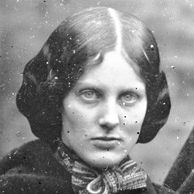
This page compares portraits of Charlotte Bronte with 'Charlotte' in the
'Bronte Sisters Photograph'. The collodion photo dates from the 1850s or 1860s, at least
50 years before the first 'unflattered' portrait of the author was seen by the public.
If it is not a photograph of Charlotte then any resemblance could only be coincidental.
Only three undisputed portraits of Charlotte Bronte exist. The most famous and
most reproduced is George Richmond's chalk drawing of 1850. A beautiful
portrait, but it is idealised, making any direct comparison with the
photo problematic.
Branwell Bronte's 1830s portrait of Charlotte
is unflattered and considered to be the most accurate likeness of
her.1. The only other undisputed image is her own
caricature.
A fourth image, Charlotte Bronte's "Portrait of a Young
Woman" is of an unidentified figure; it is included on this
page because some features resemble those of the artist, and 'Charlotte' in the
photograph. Finally, there are some contemporary descriptions of Charlotte.
|
|
Charlotte Bronte's
Caricature, 1843.
|
|
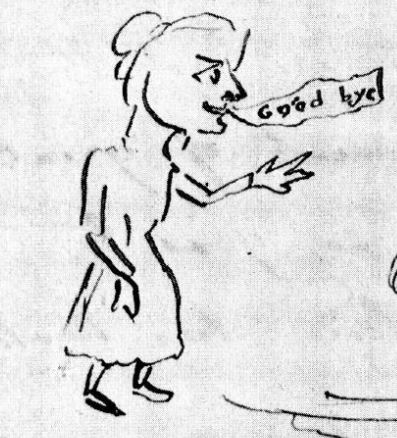
Charlotte Bronte, self-caricature,
1843. Only a rough sketch but it exaggerates the large
eyes, large mouth and prominent chin mentioned in descriptions of her. She was extremely
self-conscious about her appearance and considered her head to be too
large for her body. The sketch may suggest that her nose was
slightly retrousse, a trait in some members of the maternal Branwell
family.
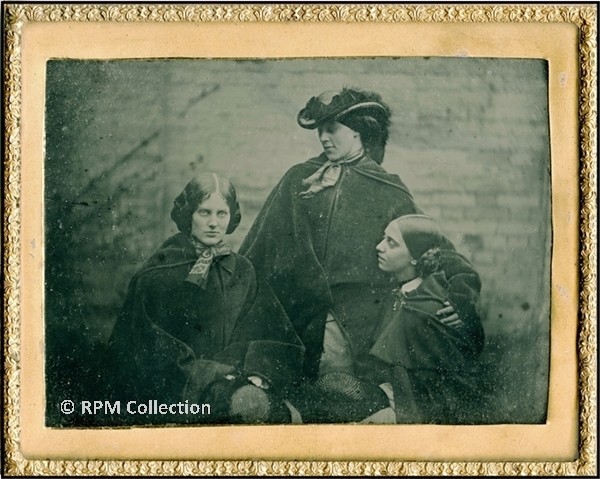
'The Bronte Sisters Photo' L-R:
'Charlotte', 'Emily', 'Anne'. All three Bronte sisters were
small in stature by the standards of today. Estimates vary: Charlotte was about 4
feet 10 inches; Emily was considered tall at about 5 feet 6 inches; Anne's height is
unknown. This was not
unusual for the time. In photographs
of Queen Victoria she is very grand and majestic, but she was only a couple of inches taller
than Charlotte Bronte.

|
|
Charlotte in Branwell's
1830s 'Pillar' portrait.
|
|
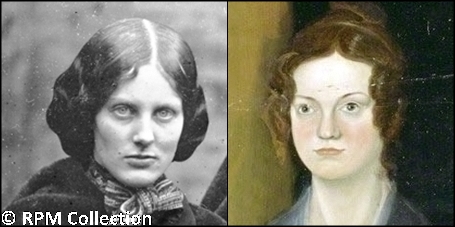
Left: 'Charlotte' in the photo. If it was
taken c1848, she would be 32-years-old.
Right: Charlotte Bronte in Branwell Bronte's 'Pillar'
portrait. Charlotte was about 18-years-old when it
was painted. She had a slightly crooked mouth, it turned downwards on her right, and her hair was parted
slightly to her left; none of this is immediately obvious in either image
but it is when the pictures are reversed.
Branwell's depiction of Charlotte
is certainly no masterpiece but it is valuable for two
reasons. Firstly, it is an unflattered portrait by someone close to her. Secondly, it was described
by Elizabeth Gaskell as bearing "a striking resemblance" to Charlotte. This was in
the 1850s and Mrs Gaskell was equally surprised because it had been painted
twenty years before. Charlotte's appearance did not change very much in her adult
life.
|
|
Charlotte Bronte by George
Richmond
|
|
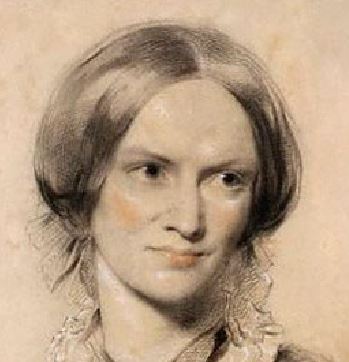 |
 |
|

|
George Richmond's portrait of Charlotte (top left)
was published in 1857. Permission had been granted by her widower
but he suppressed all other portraits. Branwell's portrait of his
sister Charlotte (top right) was discovered decades later in 1914.
In the 'Richmond' portrait Charlotte's features were idealised,
including the length of the face, nose shape and the raised height of the forehead.
It does though give some sense of the "rather overhanging
forehead" mentioned by Elizabeth Gaskell.
|
|
|
Charlotte's Pencil
Portrait of a Young Woman
|
|
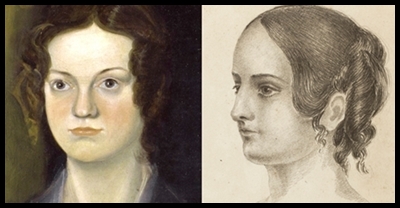
Left: Charlotte Bronte in Branwell Bronte's 'Pillar' portrait.
Right: A
pencil portrait by Charlotte Bronte of an unidentified young woman .
In the Edwardian era this unidentified pencil sketch by
Charlotte briefly appeared in a book as a portrait of Anne Bronte. It is a sketch by
Charlotte, but this certainly isn't Anne Bronte. In more recent times it
was thought that she had copied it from an illustration.
Charlotte was renowned for her large attractive eyes and her gaze and, as Anne
Thackeray Ritchie put it, "there was a general impression of chin about her
face". She certainly has the prominent jaw and chin seen in Branwell's portrait so it
is possible that this is a slightly idealised self-portrait.
If this is Charlotte then it is probably connected with her
deep interest in physiognomy and dislike of her own appearance; it would mean
that, as with the idealised portrait by George Richmond, the forehead is artificially
high and the shape of the nose may have been altered.
There is one other reason for thinking that this may
be Charlotte. The features below the forehead resemble those of 'Charlotte' in the
'Bronte Sisters Photo', including a limbal ring which is partly responsible
for the piercing eyes.

Detail from Charlotte's pencil portrait and 'Charlotte' in the photograph.
It could a portrait of a friend, a self-portrait or copied from
an illustration. There is more information on Charlotte's Portrait of a Young
Woman on the page "The Problem with
Anne".
|
|
A
description.
|
|
Elizabeth Gaskell first met Charlotte in 1850:
"the little lady worked away and hardly spoke but I had time for a good
look at her. She is (as she calls herself) UNDEVELOPED, thin, and more than half a head shorter
than I am; soft brown hair, not very dark; eyes (very good and expressive, looking straight and
open at you) of the same colour as her hair; a large mouth; the forehead square, broad and
rather over-hanging. She has a very sweet voice; rather hesitates in choosing her expressions,
but when chosen they seem without an effort admirable, and just befitting the occasion; there
is nothing overstrained, but perfectly simple."
As a child, Anne Thackeray Ritchie met Charlotte
twice:
"I remember how she frowned at me whenever I looked at
her, but perhaps it was specially at me — at least so I imagined. There was a general
impression of chin about her face."
|
|
Eyes as clear as
diamonds.
|
|
The one feature that Charlotte was renowned for in her lifetime is not really
evident in her portraits. Almost all descriptions of Charlotte refer to her
eyes. Here are some
examples:

'Charlotte' in the 'Bronte Sisters
Photo'.
Elizabeth Gaskell in The Life of Charlotte Bronte:
"...peculiar eyes, of which I find it difficult to give a description, as
they appeared to me in her later life. They were large, and well shaped; their colour a
reddish brown; but if the iris was closely examined, it appeared to be composed of a great
variety of tints. The usual expression
was of quiet, listening intelligence; but now and then, on some just occasion for vivid
interest or wholesome indignation, a light would shine out, as if some spiritual lamp had
been kindled, which glowed behind those expressive
orbs. I never saw the like in any other human
creature."
"As for the rest of her features,
they were plain, large, and ill set; but, unless you began to catalogue them, you
were hardly aware of the fact, for the eyes and power of the countenance
over-balanced every physical defect; the crooked mouth and large nose were forgotten,
and the whole face arrested the attention, and presently attracted all those whom she
herself would have cared to attract."
Joseph Marsden Dixon remembered Charlotte visiting Ellen
Nussey:
“She wor a
‘lowish’ [small]
woman...and her eyes they looked a long way into her head..."
2.
A relative of the Bronte family in Ireland who visited
Haworth as a boy:
"Charlotte had a very wee foot and small arms, and was
[short] sighted" but her
eyes were "as clear as diamonds." 3.
William Makepeace Thackeray:
"I remember the trembling little frame,
the little hand, the great honest eyes. An impetuous honesty seemed to me to characterize
the woman." 4.
Her publisher, George Smith reminisced:
"I must
confess that my first impression of Charlotte Brontë's personal appearance was that it was
interesting rather than attractive. She was very small, and had a quaint old-fashioned
look.Her head seemed too large for her body.
She had fine eyes, but her face was marred by the shape of the mouth and by the complexion.
There was but little feminine charm about her."
Matthew Arnold met
Charlotte in 1850:
"I
talked to Miss Bronte (past thirty and plain, with expressive grey eyes
though)".
Meta Gaskell on
Charlotte:
"a
dainty, bird-like creature, being delicate in appearance, slight in figure, with tiny
hands and feet, very large grey eyes, silky brown hair, and a shy, timid manner: At
times, when strangers were not present, and she was at her ease, she would become quite
impassioned in conversation, using her hands to accentuate her remarks."
5.
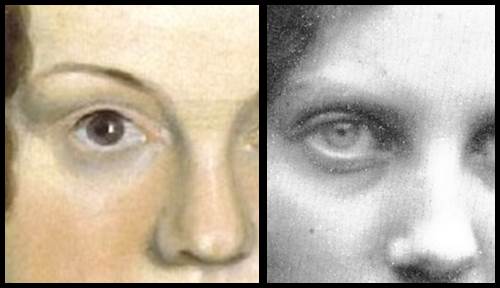
Detail from the image of Charlotte
in Branwell's 'Pillar' portrait and 'Charlotte' in the photograph. A notable feature in the photograph is the limbal ring which accentuates the
eye.
It has proved impossible to pin
down Charlotte's eye colour because the descriptions all vary: grey, blue,
blue/brown, hazel, light brown and "difficult to describe... but
reddish-brown with tints." The eye colour in Branwell's group 'Pillar' portrait may not
be accurate because the colour of the sisters' hair is supposed to be different but here
it is the same.
|
|
|
|
|
|
|
|
1. Barnard; Louise Barnard (29 March 2013). "Brontë, Patrick
Branwell". A Brontë Encyclopedia. Wiley. p.263
"Most commentators agreed on the excellence of the
likenesses, despite the crudeness of Branwell’s artistic
techniques."
Ann Dinsdale, Brontë Parsonage Museum collections manager.
Keighley News 30 July 2015.
"Branwell’s famous portrait which is believed to show
a good likeness to the real-life Charlotte, Anne and
Emily."
See the page 'Charlotte's Two
Portraits '
2.Bradford Daily Telegraph,
Thursday 20 February 1908. P.2: "CHARLOTTE BRONTE THOUGHT NOUGHT
ABOUT."
""There is still living
at Birstall an old man named Joseph Marsden Dixon who has dear remembrance of Charlotte
Bronte. When Mr. Dixon was a boy — he is now well over eighty - Charlotte Bronte used come
to Birstall to see her friend Miss Ellen Nussey, who lived near Mr. Dixon’s home. “She wor a
‘lowish’ [small] woman.” said Mr. Dixon to an interviewer last week, “and her
eyes they looked a long way into her head.... She was thought nought about at that day. She
and Miss Nussey used to walk out together in the wood behind where Wensleydale Mill
stands now." It is close upon fifty-three years since Charlotte Bronte
died.""
Site of Red House, Gomersal and site of woods, now Wensleydale Mill, Birstall -
Map.
3. The Sketch, 10
February 1897
4. One visitor to the Parsonage was mesmerized by them; although no
doubt exaggerated this is his account:
"Altogether she was as unpretending,
undemonstrative, quiet a little lady as you could well meet. Her age I took to be about
five-and-thirty. But when you saw and felt her eyes, the spirit that created Jane Eyre was
revealed at once to you. They were rather
small, but of a very peculiar colour, and had a strange lustre and intensity. They were
chameleon-like, a blending of various brown and olive tints. But they looked you through and through-and you felt they were
forming an opinion of you, not by mere acute noting of Lavaterish physiognomical
peculiarities, but by a subtle penetration into the very marrow of your mind, and the
innermost core of your soul.
Taking my hand again she apologised for her
enforced absence, and, as she did so, she looked right through me. There was no boldness in the
gaze, but an intense, direct, searching look, as of one who had the gift to read hidden
mysteries, and the right to read them. I had a feeling that I never experienced before or
since, as though I was being mesmerised. It was almost a relief when the look was removed, and
we sat down together to table. During dinner I had always a feeling that those eyes were on me,
when I was looking down myself, and when I looked at her, and her gaze was on her plate, I
still could not divest myself of the sensation that those eyes could see one through their
lids."The Free Lance, 7 and 14 March, 1868, articles
entitled "Charlotte Bronte" and "A Day with Charlotte Bronte [in 1850]" Personal
Reminiscences (of John Stores Smith).
5. Dundee Evening Telegraph - Saturday 22 May
1897.p.2. "HOW CHARLOTTE BRONTE LOOKED. "
"A great deal is now being written about
Charlotte Bronte, and in one of the magazines [Woman at Home] there is an interesting
reference to her in an article on Mrs Gaskell's house and its memories. Miss Gaskell, a
daughter of Charlotte's biographer, still living there, tells that the impression which she
retained of the author of "Jane Eyre" was of a dainty, bird-like creature, being delicate in
appearance, slight in figure, with tiny hands and feet, very large grey eyes, silky brown
hair, and a shy, timid manner: At times, when strangers were not present, and she was at her
ease, she would become quite impassioned in conversation, using her hands to accentuate her
remarks. Concerning Mr Bronte, whom she saw when she accompanied her mother to Haworth, Miss
Gaskell says that "he talked incessantly, telling story after story, and spinning yarns like
a Napier, full of point and vivid colouring,"
|
|
|

